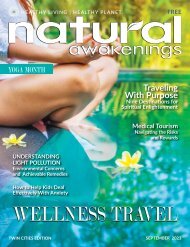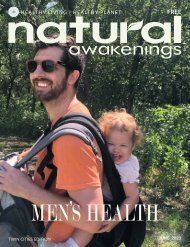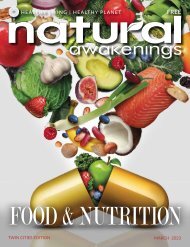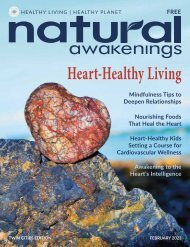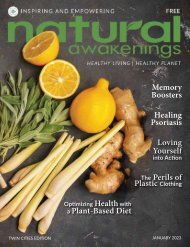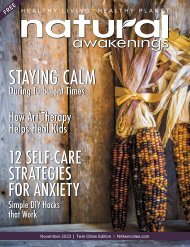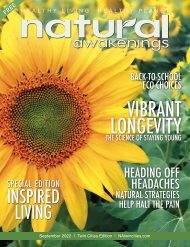Natural Awakenings Twin Cities November 2019
Natural Awakenings Twin Cities magazine is your source for healthy living, healthy planet information. Have you visited our website lately? Sign up for our Newsletter and Digital Magazine, read archived articles from local experts, and keep up with local healthy living events. Visit NATwinCities.com today. We provide a complete toolkit for businesses. List your healthy or green business for free. Enter your calendar events for free.
Natural Awakenings Twin Cities magazine is your source for healthy living, healthy planet information. Have you visited our website lately? Sign up for our Newsletter and Digital Magazine, read archived articles from local experts, and keep up with local healthy living events. Visit NATwinCities.com today.
We provide a complete toolkit for businesses. List your healthy or green business for free. Enter your calendar events for free.
Create successful ePaper yourself
Turn your PDF publications into a flip-book with our unique Google optimized e-Paper software.
Ljupco Smokovski/Shutterstock.com<br />
asleep at a regular bedtime, and when<br />
it’s advanced, experience sleepiness too<br />
early in the evening and then [have] early<br />
morning awakenings.”<br />
Circadian rhythm regulates digestion,<br />
cellular repair, hormones and many<br />
other functions. It also slows down the<br />
metabolism during night hours, helping<br />
us to stay asleep. “The circadian rhythm<br />
can be disrupted by many factors, including<br />
traveling to a different time zone, shift<br />
work and exposure to blue light late at<br />
night while binge-watching your favorite<br />
series,” says Winnel.<br />
Our natural hormonal rhythms<br />
are wired to release melatonin at certain<br />
times, allowing us to rest frequently<br />
during the day. Davies explains that an<br />
adult’s body is designed for periods of rest<br />
every 90 minutes. “Most people don’t have<br />
the opportunity to rest every 90 minutes,<br />
but if we were able to, we’d be going to<br />
bed in a state of rest, instead of exhaustion,”<br />
she says.<br />
Our bodies start producing melatonin<br />
around 9 p.m., when we should already<br />
be winding down, but too often we push<br />
ourselves to stay up to watch TV or have<br />
“me-time”, says Davies. “In reality, going to<br />
bed is the best me-time we can have.”<br />
Herbalist and licensed psychotherapist<br />
Jenn J. Allen, in Stroudsburg, Pennsylvania,<br />
Stress has become the norm, and most people don’t even<br />
realize they’re in that state. This produces stress hormones<br />
and can prevent the natural process of sleep from occurring.<br />
~Elina Winnel<br />
Sleep Tips<br />
For healthy circadian rhythm and melatonin cycles, try:<br />
4 Shutting off all screen devices, including the TV, two hours before going to bed<br />
4 Going to bed when you get that 9 p.m. slump and just taping a favorite show<br />
4 Walking barefoot and feeling the earth<br />
4 Spending quality time outside in sunlight, preferably in a natural setting<br />
4 Taking nourishing baths with natural soaps, lavender essential oil or herbs<br />
4 Designating certain time slots to not answer the phone or answer emails<br />
4 Exercising regularly and not within three hours of bedtime<br />
4 Taking a break from work every 90 minutes for two minutes of slow, deep breathing<br />
4 Breaking the caffeine habit by replacing coffee and tea with healthier alternatives<br />
For emotional components of insomnia, try:<br />
4 Going on a “worry fast” for five or 10 minutes, and then practice doing it for an<br />
hour or a full day<br />
4 Reserving time with loved ones for in-person conversations and get-togethers<br />
4 Checking in with yourself and acknowledging all emotions and fears<br />
without judgment<br />
4 Setting aside ambitions for a day to recharge<br />
4 Sleeping in without guilt—shopping and running errands can wait<br />
4 Choosing not to compare your life with others<br />
adds, “People spend up to 10 hours a day on<br />
electronic devices, which directly impacts<br />
melatonin production and stimulates the<br />
fight-or-flight response system in the brain.”<br />
Two Sides of Every Brain<br />
Smartphones and social media have piled<br />
even more on our plate, even if we enjoy<br />
them. “We’re expected to be constantly<br />
‘on’ and reachable 24/7,” observes Winnel.<br />
“This leads to an excessive reliance on our<br />
sympathetic nervous system and difficulty<br />
switching brainwave states from beta—associated<br />
with alertness—to theta and<br />
delta, which we experience during sleep.<br />
Through practice and specific exercises, it<br />
can become easier for us to reach the state<br />
of mind needed to nod off.”<br />
To support healthier sleep patterns,<br />
Winnel emphasizes the importance of<br />
using both hemispheres of the brain<br />
while awake. “Particularly in our professional<br />
lives, logical and rational processes<br />
are rewarded, while creativity is seen<br />
as optional. This can cause a chronic<br />
imbalance in the way we use the two<br />
hemispheres of our brain. Optimal sleep<br />
requires equalized functioning in the<br />
neurological structures that are unique to<br />
each hemisphere.” Mindful breathing and<br />
alternate-nostril yogic breathwork can<br />
also bring harmony to both hemispheres<br />
of the brain and promote deep relaxation.<br />
Promising Plant Allies<br />
Chronic pain can also prevent sound<br />
sleep. Allen stresses, “It’s important to<br />
understand what is actually causing pain<br />
and what type of pain it is. Some chronic<br />
pain comes from postural issues or injuries,<br />
so massage, chiropractic or gentle<br />
movement like yoga can help to drastically<br />
reduce the intensity of pain.”<br />
Identifying nutritional deficiencies<br />
and supporting the nervous system is also<br />
key. “Plants work both physiologically<br />
and energetically. Gentle nervine herbs<br />
like oats or chamomile can help to soothe<br />
the nervous system, and are effective for<br />
children and teens. Adaptogenic plants are<br />
known historically for helping the body<br />
to resist physical, chemical or biological<br />
stresses. Tulsi and ashwagandha, when<br />
taken consistently, can be useful in helping<br />
<strong>November</strong> <strong>2019</strong><br />
17



